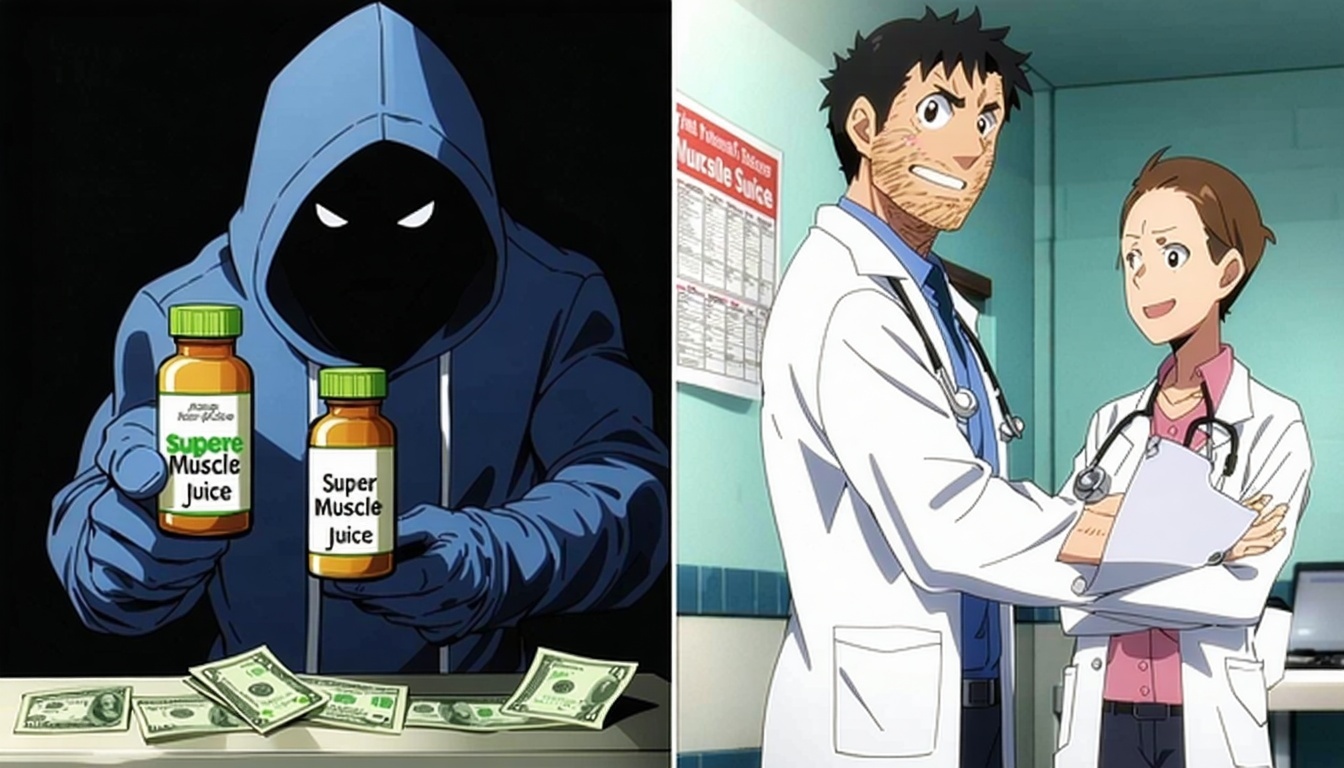The Modern Man's Guide to Legitimate Hormone Optimization: From Underground to Doctor's Office
Remember when getting testosterone meant knowing a guy who knew a guy in the gym? Those sketchy days are officially over, and your liver is probably relieved.
The world of hormone optimization has undergone a massive transformation. What was once the exclusive domain of underground bodybuilders and black market dealers has evolved into a legitimate medical field with doctor-prescribed treatments, pharmacy-sourced medications, and proper medical supervision. But with this evolution comes confusion, misinformation, and a whole lot of marketing hype.
If you're a busy professional in your 30s or 40s feeling like your energy, strength, and vitality aren't what they used to be, you've probably wondered about hormone optimization. Maybe you've seen the ads promising to restore your "youthful vigor" or heard gym buddies talking about their "TRT journey." But how do you separate legitimate medical treatment from expensive snake oil?
This comprehensive guide will walk you through everything you need to know about modern hormone optimization. We'll cover the evolution from black market to medical mainstream, break down your treatment options, teach you how to spot legitimate providers versus sketchy operations, and give you a practical roadmap for getting started safely and effectively.
By the end of this guide, you'll understand the difference between legitimate hormone therapy and the Wild West of unregulated treatments. You'll know what questions to ask, what red flags to avoid, and how to make informed decisions about your health and performance optimization.
The Evolution: From Black Market to Medical Mainstream
Let's start with a little history lesson, because understanding where we've been helps explain where we are now.
The Underground Era
For decades, hormone optimization was synonymous with the underground steroid culture. Bodybuilders and athletes seeking performance enhancement had to navigate a shadowy world of gym dealers, internet forums with cryptic vendor reviews, and substances of questionable origin and purity. The risks were enormous – contaminated products, legal consequences, health complications from unsupervised use, and zero quality control.
This underground culture created a stigma around hormone use that persists today. The association with cheating, illegal activity, and dangerous health practices made hormone optimization taboo in mainstream society. Even legitimate medical uses were viewed with suspicion.
The Cultural Shift Drivers
Several factors converged to legitimize hormone optimization:
The Aging Population: As Baby Boomers and Gen X hit middle age, the demand for age-related health solutions exploded. Men experiencing declining energy, reduced muscle mass, and decreased libido weren't content to "just accept it as part of aging."
Telehealth Expansion: The COVID-19 pandemic accelerated telehealth adoption, making medical consultations more convenient and accessible. Suddenly, you could consult with a hormone specialist from your office during lunch break.
Medical Legitimization: The medical community began recognizing hormone optimization as a legitimate field of medicine, not just treatment for severe deficiency. Anti-aging medicine and functional medicine practitioners embraced hormone therapy as part of comprehensive health optimization.
Reduced Stigma: Open discussions about men's health, mental health, and performance optimization became more socially acceptable. Celebrities and athletes began openly discussing their hormone therapy, normalizing the conversation.
The Regulatory Landscape
The regulatory environment has evolved significantly, though it remains complex:
FDA Oversight: While the FDA banned direct-to-consumer "low-T" advertising in 2015 due to exaggerated claims, they still allow off-label prescribing of testosterone and other hormones for legitimate medical purposes.
DEA Regulations: The DEA has implemented stricter guidelines for telehealth prescribing, requiring legitimate doctor-patient relationships and proper medical evaluations.
State Variations: Different states have different telemedicine laws, creating a patchwork of regulations that providers must navigate.
Compounding Pharmacy Rules: Most telehealth hormone therapy relies on compounding pharmacies, which operate under different regulations than traditional pharmaceutical manufacturers.
Market Growth and Statistics
The numbers tell the story of this transformation:
- The testosterone supplement market reached $1.85 billion in 2023
- Telehealth hormone therapy companies have seen explosive growth since 2020
- Men's health clinics have proliferated across the country
- Online searches for hormone optimization terms have increased 300% over the past five years
This isn't just a trend – it's a fundamental shift in how we approach men's health and aging.
Treatment Landscape: Your Options Explained
Now that you understand how we got here, let's break down your actual options. The modern hormone optimization landscape offers several legitimate pathways, each with distinct benefits, risks, and considerations.
Testosterone Optimization
Traditional Testosterone Replacement Therapy (TRT)
TRT involves directly replacing testosterone through injections, gels, or pellets. It's the most straightforward approach – your body isn't producing enough testosterone, so we give you testosterone.
How it works: Exogenous testosterone supplements your natural production, typically aiming for levels in the upper-normal range (700-1000 ng/dL).
Benefits:
- Predictable and reliable results
- Extensive research and clinical experience
- Multiple delivery methods available
- Relatively affordable ($99-400/month)
Drawbacks:
- Shuts down natural testosterone production
- Potential fertility impacts
- Requires ongoing treatment
- Possible side effects (acne, mood changes, cardiovascular risks)
For a comprehensive guide to accessing TRT through telehealth platforms, check out our detailed post on Telehealth TRT: How to Get Testosterone Therapy Without Leaving Your Office.
Enclomiphene Citrate: The Fertility-Friendly Alternative
Enclomiphene citrate represents a newer approach to testosterone optimization. Instead of replacing testosterone, it stimulates your body to produce more naturally.
How it works: As a selective estrogen receptor modulator (SERM), enclomiphene blocks estrogen receptors in the hypothalamus, triggering increased production of luteinizing hormone (LH) and follicle-stimulating hormone (FSH), which then stimulate natural testosterone production.
Benefits:
- Preserves natural testosterone production
- Maintains fertility
- Oral administration (no injections)
- Easily reversible
- Can double testosterone levels naturally
Considerations:
- More expensive than basic TRT ($199-250/month)
- Less predictable results than direct replacement
- Limited long-term data
- May not work for everyone
For an in-depth analysis of enclomiphene citrate, including clinical studies and real-world results, read our comprehensive guide: Enclomiphene Citrate: The Testosterone Booster That Doesn't Shut You Down.
Growth Hormone Optimization
Sermorelin: The Smart HGH Alternative
Growth hormone optimization has traditionally been expensive and risky, involving direct HGH injections that cost $1,600+ per month. Sermorelin offers a smarter approach.
How it works: Sermorelin is a growth hormone-releasing hormone (GHRH) analog that stimulates your pituitary gland to produce more natural growth hormone, rather than replacing it directly.
Benefits:
- Stimulates natural HGH production
- Much more affordable than direct HGH ($200-400/month)
- Better safety profile
- Improves sleep quality, recovery, and body composition
- Supports healthy aging
Considerations:
- Results may take longer to appear than direct HGH
- Individual response varies
- Requires consistent administration
- Limited insurance coverage
Learn more about sermorelin therapy and how it compares to expensive HGH treatments in our detailed analysis: Sermorelin: The Growth Hormone Hack That Won't Break the Bank.
Advanced Peptide Therapy
Beyond sermorelin, the peptide therapy world offers numerous options for optimization enthusiasts:
- Ipamorelin: Another growth hormone releasing peptide with excellent safety profile
- CJC-1295: Longer-acting GHRH analog often combined with ipamorelin
- BPC-157: "Body protection compound" for healing and recovery
- TB-500: Thymosin beta-4 for tissue repair and recovery
For a comprehensive overview of peptide therapy options beyond sermorelin, including stacking protocols and safety considerations, check out: Peptide Therapy Explained: Beyond Sermorelin to the Cutting Edge.
Advanced Protocols and Combinations
HCG Integration for Fertility Preservation
Human chorionic gonadotropin (HCG) can be added to hormone protocols to maintain testicular function and preserve fertility, especially important for men planning families.
Learn about HCG protocols and fertility preservation strategies in our guide: HCG and Hormone Optimization: The Fertility Preservation Protocol.
Hormone Stacking for Advanced Users
Experienced users may combine multiple treatments for synergistic effects, such as testosterone + sermorelin + HCG protocols.
For advanced combination strategies and safety protocols, see: Hormone Optimization Stacking: Combining Treatments for Maximum Results.
Provider Evaluation: Separating Legitimate from Sketchy
Here's where things get tricky. The hormone optimization boom has attracted everyone from legitimate medical professionals to outright scammers. Learning to distinguish between them could save your health, your money, and your sanity.
Red Flags: Warning Signs to Avoid
Marketing and Claims Red Flags
"Fountain of Youth" Promises: Any provider claiming their treatments will make you feel 20 again or promising miraculous transformations is selling fantasy, not medicine.
Before/After Photos: Dramatic transformation photos are often misleading, using different lighting, poses, or even different people.
Celebrity Endorsements: Paid promotional content from celebrities or influencers should be viewed with extreme skepticism.
"Secret" or "Breakthrough" Claims: Legitimate medicine doesn't rely on "secrets" or "breakthroughs" that only one provider knows about.
Pressure Tactics: "Limited time offers," countdown timers, and high-pressure sales tactics have no place in medical care.
Medical Practice Red Flags
No Licensed Physician: If you're not consulting with an actual doctor, you're not getting medical care.
Minimal Lab Requirements: Legitimate hormone therapy requires comprehensive lab work before, during, and after treatment.
One-Size-Fits-All Protocols: Everyone gets the same treatment regardless of individual needs, lab results, or medical history.
No Medical History Review: Skipping comprehensive medical history and current health assessment.
Immediate Start: Pushing you to start treatment immediately without proper evaluation.
Financial Red Flags
Unusually Low Prices: If it seems too good to be true, it probably is. Quality medical care and pharmaceutical-grade medications cost money.
Large Upfront Payments: Demanding months of payment in advance.
Hidden Fees: Undisclosed costs for labs, consultations, or "administrative fees."
Cash-Only Operations: Refusing to work with insurance or provide proper documentation.
For a comprehensive red flags checklist and detailed provider evaluation criteria, read our consumer protection guide: Red Flags: How to Spot Sketchy Hormone Clinics (And Avoid Getting Scammed).
Green Flags: Signs of Legitimate Providers
Medical Credentials and Oversight
Licensed Physicians: Board-certified doctors should be directly involved in your care, not just rubber-stamping protocols.
Medical Supervision: Ongoing physician oversight throughout your treatment, not just initial consultation.
Facility Licensing: Proper medical facility credentials and state licensing.
Professional Associations: Membership in relevant medical organizations and continuing education.
Comprehensive Medical Approach
Thorough Evaluation: Complete medical history, physical examination, and comprehensive lab work.
Individualized Protocols: Treatment plans customized to your specific needs, goals, and lab results.
Risk Assessment: Honest discussion of potential side effects, risks, and contraindications.
Monitoring Plans: Regular follow-up appointments and lab work to track progress and adjust treatment.
Transparent Business Practices
Clear Pricing: Upfront disclosure of all costs with no hidden fees.
Detailed Contracts: Clear terms and conditions, cancellation policies, and patient rights.
Professional Communication: Responsive, knowledgeable staff who can answer medical questions.
The Regulatory Environment
Understanding the regulatory landscape helps you evaluate provider legitimacy:
FDA Oversight: The FDA regulates hormone medications but doesn't approve compounded formulations. Legitimate providers will explain this distinction.
DEA Regulations: Controlled substances like testosterone require proper DEA registration and compliance.
State Medical Boards: Physicians must be licensed in the state where they practice telemedicine.
Compounding Pharmacy Standards: Medications should come from licensed, accredited compounding pharmacies.
For a detailed explanation of the regulatory environment and what it means for patients, see: The FDA, DEA, and Your Hormones: Understanding the Regulatory Landscape.
Cost-Benefit Analysis: Investment in Optimization
Let's talk money. Hormone optimization isn't cheap, and most insurance plans won't cover it. But understanding the true costs and potential returns helps you make informed decisions.
Treatment Cost Breakdown
Initial Costs
- Consultation: $100-300 for initial evaluation
- Lab Work: $150-200 for comprehensive hormone panel
- Follow-up Labs: $100-150 every 3-6 months
Monthly Treatment Costs
- Basic TRT: $99-129/month (budget providers)
- Premium TRT: $200-400/month (comprehensive programs)
- Enclomiphene: $199-250/month
- Sermorelin: $200-400/month
- Combination Protocols: $300-600/month
Annual Investment Ranges
- Budget Approach: $1,500-2,000/year
- Comprehensive Program: $3,000-5,000/year
- Premium Optimization: $5,000-8,000/year
Insurance Considerations
Most hormone optimization treatments aren't covered by insurance, but there are exceptions and strategies:
Medical Necessity: If you have clinically low testosterone (typically <300 ng/dL), insurance may cover basic TRT.
HSA/FSA Eligibility: Many treatments qualify for health savings account reimbursement.
Appeal Processes: Some patients successfully appeal insurance denials with proper documentation.
For detailed strategies on insurance navigation and cost reduction, check out: Insurance and Hormone Therapy: What's Covered (And What's Not).
ROI Calculation Framework
How do you calculate return on investment for health optimization? Consider these factors:
Health Improvements
- Increased energy and productivity
- Better sleep quality and recovery
- Improved body composition
- Enhanced mood and mental clarity
- Reduced risk of age-related health issues
Quality of Life Enhancements
- Better relationships and social interactions
- Increased confidence and self-esteem
- Enhanced physical performance and capabilities
- Greater life satisfaction and well-being
Long-term Health Cost Savings
- Reduced healthcare costs from preventable conditions
- Lower risk of cardiovascular disease
- Maintained bone density and muscle mass
- Better metabolic health and diabetes prevention
For budget-conscious approaches to hormone optimization, see our cost optimization guide: Hormone Optimization on a Budget: Maximizing Results While Minimizing Costs.
Safety and Risk Management
Let's address the elephant in the room: hormone optimization isn't risk-free. Understanding and managing these risks is crucial for safe, effective treatment.
Common Side Effects by Treatment Type
Testosterone Therapy
- Acne and oily skin
- Mood changes (irritability, aggression)
- Sleep apnea worsening
- Fluid retention
- Testicular shrinkage (with TRT)
- Fertility reduction (with TRT)
Growth Hormone/Peptide Therapy
- Injection site reactions
- Water retention
- Joint pain
- Carpal tunnel syndrome
- Insulin resistance (rare)
Serious Risks and Warning Signs
Cardiovascular Risks: Some studies suggest increased risk of heart attack and stroke, particularly in older men with existing cardiovascular disease.
Blood Clot Risk: Testosterone can increase red blood cell production, potentially increasing clot risk.
Prostate Concerns: While testosterone doesn't cause prostate cancer, it may accelerate existing cancer growth.
Liver Stress: Oral testosterone formulations can stress the liver (injectable forms are safer).
Monitoring Requirements
Proper monitoring is essential for safe hormone optimization:
Essential Lab Tests
- Hormone Levels: Total and free testosterone, estradiol, LH, FSH
- Safety Markers: Complete blood count, comprehensive metabolic panel
- Cardiovascular: Lipid panel, blood pressure monitoring
- Prostate: PSA (prostate-specific antigen)
- Liver Function: ALT, AST (especially with oral medications)
Monitoring Frequency
- First 3 months: Monthly lab work and check-ins
- Stable phase: Every 3-6 months
- Long-term: At least twice yearly
For a comprehensive guide to understanding your lab results and tracking progress, see: Lab Work Decoded: Understanding Your Hormone Test Results.
Risk Mitigation Strategies
- Start Low, Go Slow: Begin with conservative doses and adjust based on response
- Regular Monitoring: Don't skip lab work or follow-up appointments
- Lifestyle Optimization: Maintain healthy diet, exercise, and sleep habits
- Medical Supervision: Work with qualified healthcare providers
- Emergency Planning: Know when to seek immediate medical attention
For an honest, comprehensive analysis of hormone therapy risks and how to manage them, read: Hormone Therapy Side Effects: The Real Risks Nobody Talks About.
Cultural Considerations: Navigating the "Natural" Debate
Hormone optimization exists in a cultural gray area that's worth understanding, especially if you're involved in fitness, bodybuilding, or competitive sports.
The Natural vs. Enhanced Spectrum
The fitness community has long debated what constitutes "natural" versus "enhanced" training. Hormone optimization complicates this binary:
Traditional "Natural": No exogenous hormones or performance-enhancing substances
Medical TRT: Prescribed testosterone for legitimate medical reasons
Optimization TRT: Testosterone therapy for performance and quality of life enhancement
Enhanced/Open: Acknowledged use of performance-enhancing substances
Competition Implications
If you compete in "natural" bodybuilding or powerlifting federations, hormone therapy may affect your eligibility:
Strict Natural Federations: Organizations like INBA/PNBA typically don't allow any exogenous hormones, including prescribed TRT.
Age-Based Considerations: Some federations have different rules for masters (40+) competitors.
Enhanced Categories: Some organizations are creating TRT-allowed divisions.
Testing Challenges: Distinguishing between therapeutic and performance doses can be difficult.
For a deep dive into this contentious debate and where TRT fits in modern fitness culture, read: The Natural vs. Enhanced Debate: Where TRT Fits in Modern Fitness.
Social Acceptance Factors
Cultural attitudes toward hormone optimization are rapidly evolving:
Age Factor: More acceptance for men over 35-40 experiencing natural decline
Medical Legitimacy: Doctor-prescribed treatments carry more social acceptance
Transparency: Open discussion reduces stigma and misinformation
Generational Differences: Younger generations more accepting of optimization approaches
Psychological Considerations
The decision to pursue hormone optimization often involves complex psychological factors:
Masculinity Concerns: Societal pressure to maintain strength and virility
Aging Anxiety: Fear of declining performance and attractiveness
Performance Pressure: Competitive workplace and social environments
Control Issues: Desire to optimize and control health outcomes
For a thoughtful exploration of the psychological factors driving interest in hormone optimization, see: Hormone Optimization and Masculinity: Unpacking the Psychology.
Implementation Roadmap: Getting Started
Ready to explore hormone optimization? Here's your step-by-step roadmap for getting started safely and effectively.
Step 1: Self-Assessment and Goal Setting
Before diving into treatment, honestly assess your situation:
Symptom Evaluation
- Energy Levels: Persistent fatigue despite adequate sleep
- Physical Performance: Declining strength, endurance, or recovery
- Body Composition: Increasing fat, decreasing muscle mass
- Mental Health: Mood changes, decreased motivation, brain fog
- Sexual Health: Reduced libido, erectile dysfunction
Goal Clarification
- Health Goals: Improved energy, better sleep, enhanced recovery
- Performance Goals: Increased strength, better body composition
- Quality of Life Goals: Enhanced mood, increased confidence
- Longevity Goals: Healthy aging, disease prevention
Step 2: Initial Research and Education
Educate yourself before making decisions:
- Read reputable sources and scientific studies
- Understand different treatment options and their trade-offs
- Learn about potential risks and side effects
- Research provider options in your area or via telehealth
Step 3: Provider Evaluation and Selection
Use the criteria we discussed earlier to evaluate potential providers:
- Verify medical credentials and licensing
- Check reviews and testimonials (but be skeptical of perfect reviews)
- Evaluate their approach to patient care and monitoring
- Compare pricing and service offerings
- Schedule consultations with 2-3 top candidates
Step 4: Initial Consultation and Lab Work
During your consultation, expect:
- Medical History Review: Comprehensive health background
- Symptom Assessment: Detailed discussion of your concerns
- Physical Examination: Basic health evaluation
- Lab Work Orders: Comprehensive hormone and health panels
- Treatment Discussion: Options based on your situation
Step 5: Treatment Selection and Initiation
Based on your lab results and goals, work with your provider to select the most appropriate treatment:
- Conservative Approach: Start with lifestyle optimization and monitoring
- Moderate Intervention: Begin with enclomiphene or low-dose TRT
- Comprehensive Protocol: Combination therapy for multiple optimization goals
Step 6: Monitoring and Optimization
Successful hormone optimization requires ongoing attention:
- Regular Lab Work: Track progress and adjust protocols
- Symptom Monitoring: Keep a journal of energy, mood, and performance
- Lifestyle Integration: Maintain healthy diet, exercise, and sleep habits
- Protocol Adjustments: Fine-tune dosing and timing based on results
For a comprehensive, time-efficient implementation guide designed specifically for busy professionals, check out: The Busy Professional's Guide to Starting Hormone Optimization.
Conclusion: Your Hormone Optimization Journey
The evolution of hormone optimization from underground bodybuilding practice to legitimate medical treatment represents one of the most significant shifts in men's health in decades. What was once risky, illegal, and stigmatized has become accessible, safe, and increasingly accepted.
But with this legitimization comes responsibility – both for providers to offer safe, effective treatments and for patients to make informed decisions based on science, not marketing hype.
Key Takeaways
- Legitimacy Matters: The difference between legitimate medical treatment and sketchy operations can be the difference between improved health and serious complications.
- Education is Essential: Understanding your options, risks, and realistic expectations is crucial for success.
- Quality Costs Money: Legitimate hormone optimization isn't cheap, but the investment in your health and quality of life can be worthwhile.
- Monitoring is Mandatory: Ongoing medical supervision and lab work aren't optional – they're essential for safety.
- Individual Results Vary: What works for your gym buddy might not work for you. Personalized medicine is key.
Action Steps for Readers
If you're considering hormone optimization:
- Start with Education: Read the linked articles in this guide to deepen your understanding
- Assess Your Situation: Honestly evaluate your symptoms, goals, and readiness for treatment
- Research Providers: Use our red flags checklist to evaluate potential providers
- Get Baseline Labs: Even if you're not ready for treatment, knowing your current levels is valuable
- Consider Lifestyle First: Optimize sleep, nutrition, exercise, and stress management before adding hormones
Resources for Continued Learning
This guide provides a comprehensive overview, but hormone optimization is a complex field that continues to evolve. Stay informed by:
- Following reputable medical sources and research
- Joining patient communities and forums (but verify information)
- Working with qualified healthcare providers
- Monitoring regulatory changes and new treatment options
Final Thoughts
Hormone optimization isn't a magic bullet, and it's not right for everyone. But for men experiencing the effects of declining hormones – whether due to aging, stress, or medical conditions – legitimate hormone therapy can be life-changing.
The key is approaching it with the right mindset: as a medical treatment that requires proper evaluation, ongoing monitoring, and realistic expectations. It's not about turning back the clock to your 20s; it's about optimizing your health and quality of life for the decades ahead.
Remember, the goal isn't to become superhuman – it's to become the best version of yourself. And in 2024, that's more achievable than ever before, thanks to the evolution from underground to doctor's office.
Medical Disclaimer: This content is for educational purposes only and does not constitute medical advice. Hormone optimization should only be undertaken under the supervision of qualified healthcare providers. Individual results may vary, and all medical treatments carry risks. Consult with a licensed physician before starting any hormone therapy program.
Related Articles in This Series
- Enclomiphene Citrate: The Testosterone Booster That Doesn't Shut You Down
- Sermorelin: The Growth Hormone Hack That Won't Break the Bank
- TRT vs. Enclomiphene: The Ultimate Testosterone Showdown
- Peptide Therapy Explained: Beyond Sermorelin to the Cutting Edge
- Telehealth TRT: How to Get Testosterone Therapy Without Leaving Your Office
- Bioidentical Hormones: Marketing Hype or Medical Marvel?
- HCG and Hormone Optimization: The Fertility Preservation Protocol
- Hormone Optimization Stacking: Combining Treatments for Maximum Results
- Red Flags: How to Spot Sketchy Hormone Clinics (And Avoid Getting Scammed)
- The FDA, DEA, and Your Hormones: Understanding the Regulatory Landscape
- Compounding Pharmacies: The Good, The Bad, and The Unregulated
- Hormone Therapy Side Effects: The Real Risks Nobody Talks About
- Lab Work Decoded: Understanding Your Hormone Test Results
- Insurance and Hormone Therapy: What's Covered (And What's Not)
- From Taboo to Mainstream: The Cultural Evolution of Hormone Optimization
- The Natural vs. Enhanced Debate: Where TRT Fits in Modern Fitness
- Hormone Optimization and Masculinity: Unpacking the Psychology
- The Veteran's Dilemma: Military Culture and Hormone Therapy
- Age and Hormones: When Optimization Becomes Necessary (Not Just Desired)
- Women and Hormone Optimization: Beyond Menopause
- The Busy Professional's Guide to Starting Hormone Optimization
- Hormone Optimization on a Budget: Maximizing Results While Minimizing Costs
- Monitoring and Optimization: Getting the Most from Your Hormone Therapy
- Travel and Hormone Therapy: Maintaining Your Protocol on the Road
- The Future of Hormone Optimization: What's Coming Next




